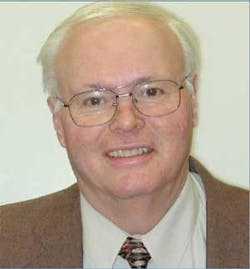Robert R. Alfano, Ph.D., has a knack for earning both accolades and research funding. The Distinguished Professor of Science and Engineering at City College and Graduate School, City University of New York, Alfano’s drive for innovation has led him to make some remarkable discoveries that have furthered biomedical optics in addition to fields such as optical communications, solid-state physics, and metrology. For example, his discovery of the white-light supercontinuum laser is at the root of optical coherence tomography, which is breaking barriers in ophthalmology, cardiology, and oral-cancer detection (see “Multiple beams boost resolution of OCT”) among other applications.
Alfano’s technical and organizational contributions won him the Coherent Lifetime Achievement Award in Biomedical Optics in 2002; and earlier this year, he received the Optical Society’s Charles Hard Townes Award for work including the white-light supercontinuum discovery, and in tunable chromium lasers: forsterite, emerald, and CUNYITE (named for, you guessed it, City University of New York).
Those are just a few of the kudos he’s earned. As for funding, he recently calculated he has brought in $62 million to CUNY during his career, averaging $1.7 million per year. He accomplished this by hitting the pavement: he developed a habit of reaching out to funding partners to get them interested in his work.
This approach has paid off for the university, for his students (of his 51 Ph.D. students, 10 have done their theses in biomedical optics), and for himself—listening to him talk, you can just tell that Bob Alfano has a lot of fun doing what he does.
This accomplished scientist notes that he attended college mainly because his father thought it was important (though his parents hadn’t had such advantage). Alfano chose Farleigh Dickinson University because it was close to his childhood home in New Jersey, and started his secondary education thinking he’d end up an electrical engineer like his uncle. But at FDU he discovered strengths he was able to build upon, and his life took a different direction.
Having a talent for mathematics, he took all the math classes he possibly could–and found a way to have them count against his liberal arts requirements. And wanting to avoid the EE curriculum’s lab requirements, he switched his major to physics, which required far fewer. It’s a bit ironic that he hated the lab requirements for his physics degree.
Telling the story of his education and career, Alfano frequently uses the word “lucky.” And while there’s no doubt that the timing of some events in his history are uncanny, it’s also clear that his success has a lot to do with work and smarts.
After earning his bachelor’s degree, he submitted an application for employment to General Telephone and Electronics Laboratories (now Verizon, then the competitor nipping at the heels of Bell Telephone) and received a rejection letter. Simultaneously, he sent a letter to Sylvania, a General Telephone (GTE) subsidiary. The interviewer was impressed with Alfano’s knowledge of physics, and called upon Dr. Esther Conwell, a famous solid-state theorist at GTE, to complete the interview. Conwell, recognized his understanding of quantum mechanics and feel for physics concepts. The company offered him a position; and he later ended up getting the job for which he’d been rejected, working for Conwell.
At GTE he found a good “home” for his work, an important colleague, Stanley Shapiro, and some critical mentors including Joseph Birman and Alexander Lempicki. Early on, while working on optical phonon lifetimes, the basis for his doctoral thesis, he accidentally discovered the white-light supercontinuum laser. “I thought there was something wrong with the experiment,” he said. “For three months I worked to find the source of my error, because what I was seeing just didn’t seem possible.” He jokes that he used up a lot of black masking tape trying to seal the spectrograph that he assumed was leaking light.
Alfano left GTE only because the company reorganized and relocated, breaking up his team. He was sorely disappointed; any chance he and Shapiro had of winning a Nobel Prize was quashed. Shapiro moved west to join Los Alamos National Laboratory, and Alfano found his way to CUNY, where he created another avenue for contributing to scientific discovery. At the suggestion of then-provost Harry Lustig, he founded and became director of the Institute for Ultrafast Spectroscopy and Lasers (IUSL). Since its launch in 1983, IUSL has grown to become a major academic center for biomedical optics research.
Alfano has made a number of other original pioneering contributions in biomedical optics in the use of light for noninvasive detection and diagnosis of diseases; in particular, cancers and atherosclerosis. His innovative application of fluorescence, excitation, and Raman spectroscopic techniques to distinguish between normal and cancerous tissues, as well as benign and normal tumors of human body was the basis for the beginning of the field of optical biopsy.
His contributions in fundamentals of light propagation in turbid media led to the development of different gating techniques for sorting out image-bearing photons for direct imaging of structures within biological tissues. He helped lead the development of many of these photon-sorting techniques; he also leads a major effort dedicated to the development of three-dimensional inverse image reconstruction techniques using a sequence of time-resolved two-dimensional images for optical mammography.
In addition to his technical contributions, he has encouraged the growth of the field by organizing topical meetings and conferences for OSA and SPIE, and later cochaired many optical imaging conferences with Britton Chance, training young scientists and engineers, and attracting other researchers to enter the field.
His contributions to photonics are documented in more than 700 research articles, 102 patents, several edited volumes and conference proceedings, and well over 10,000 citations. He holds 45 patents and published over 230 articles in the biomedical optics area alone.
Alfano demonstrated the potential use of optical spectroscopy in the diagnosis of diseases and opened up the field of optical biopsy in 1984. In fact, he introduced the term “optical biopsy.”
In 1981 Alfano used fluorescence spectroscopy and time-resolved kinetics to detect cavities in human teeth. Then, in 1984, he was the first to detect cancer using the native fluorescence spectroscopy of tissue without extrinsic dyes. In a series of experiments, his group demonstrated that these spectroscopic techniques have the potential to provide the diagnostic ability to distinguish between normal tissues and tumors, as well as between malignant and benign tumors. A major breakthrough was his use of near-ultraviolet and blue light for excitation of proteins and amino acids in tissues, and recognition of the ratio of peak fluorescence intensities emitted by biological tissues at two wavelengths (such as the 340 nm peak associated with tryptophan and the 440 nm peak associated with collagen and elastin) as a parameter for identification of the tissue as normal or cancerous. This observation has enabled noninvasive detection of cancer based on fluorescence ratio, and obtaining a fluorescence ratio map to identify a suspect region of a body organ as normal, precancerous, or cancerous with high sensitivity and specificity over 90%.
His group was the first to use Raman spectroscopy, starting in 1991, to diagnose cancers in human breast tissue.
Detailed understanding of light propagation through highly scattering turbid media (which is what biological tissue is), is crucial to the development of optical biomedical imaging techniques. Alfano carried out concerted experimental and theoretical investigations to address the issue. The work by his group led to the development of the concept and elucidation of the properties of ballistic, snake, and diffusive photons based on the time of flight of photons within the media. He introduced the terms ballistic and snake photons, and identified these photons as carriers of information for direct shadowgram imaging. Comprehending of the characteristics of these photons led to the development of various gating techniques for sorting out image-bearing photons for direct two-dimensional imaging of inhomogeneities in turbid media in general, and biomedical samples in particular.
While at General Telephone, Alfano did not mind being part of the “underdog” company, competing against the frontrunner. That theme has carried throughout his life. He gets inspiration wherever he can find it, and is happy to go nose to nose with the world’s most prestigious institutions. He has made City College and IUSL an international competitor, among the best in photonics research. Asked what motivates him, he says, “I like to discover new things, find something completely unexpected…and I like to be number one.” That philosophy has benefited biomedical optics in many ways.
About the Author

Barbara Gefvert
Editor-in-Chief, BioOptics World (2008-2020)
Barbara G. Gefvert has been a science and technology editor and writer since 1987, and served as editor in chief on multiple publications, including Sensors magazine for nearly a decade.
